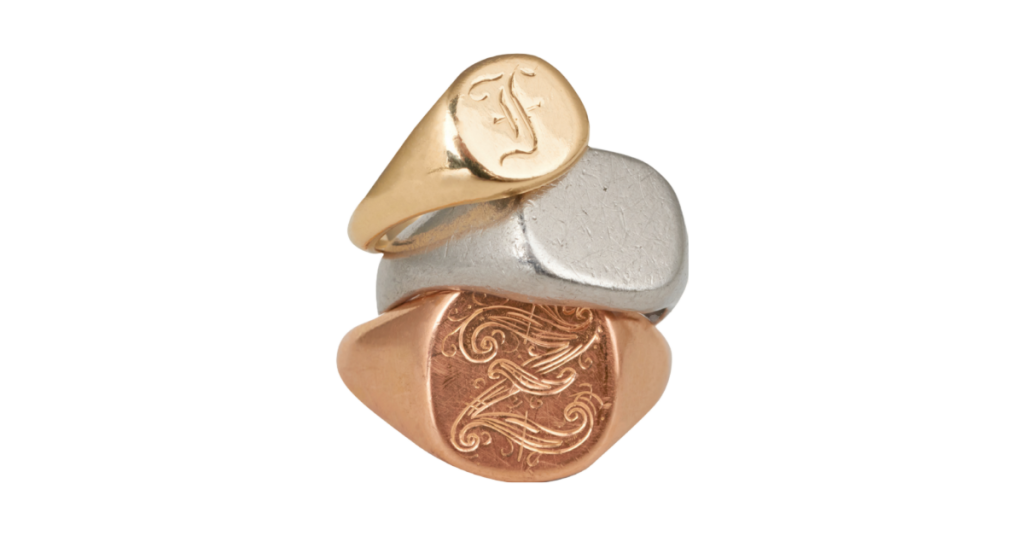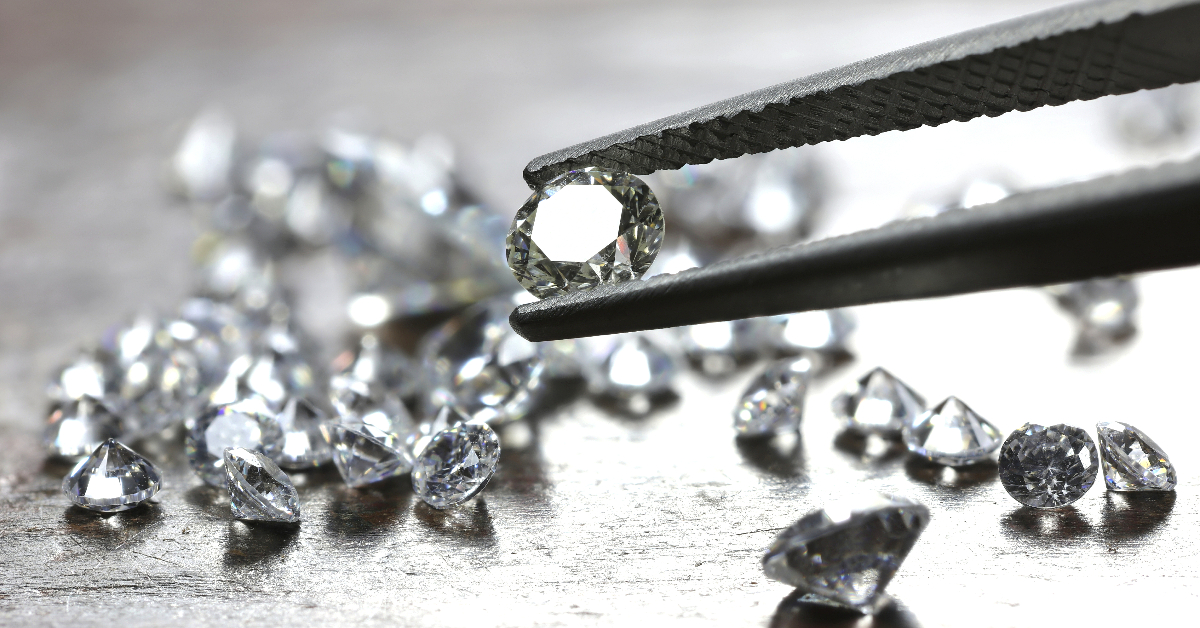The Modern Guide to Signet Rings: From Heirloom to Must-Have Accessory

Once seen as an indicator of social standing, signet rings are enjoying a major resurgence, particularly amongst millennials, Gen-Z and women. Originally used as a security device, their origins are found in Ancient Egypt. Although signet rings no longer have a practical purpose, they remain one of the most popular types of jewellery and have become a modern must-have accessory. In this article we explore the unique history of signet rings, the famous faces who wear them and the styles you need to know. Finally, we discover why they are officially cool again.
What is a Signet Ring?
Signet rings have a raised, flat surface. Usually made from gold or silver, the surface can either be left plain, engraved, or set with a precious or semi-precious stone. From the Latin ‘signum‘ meaning ‘an identifying sign or mark’, the suffix ‘et’ means ‘little’, so ‘a little symbol’. Just as a signature identifies you, a signet ring also shows the world who you are.
What are the Origins and History of Signet Rings?
In Ancient Egypt, the pharaohs wore seals attached to a ring to show their position. Under the Romans, signet rings started to become more decorative with the addition of scrollwork and gemstones. Still with a practical purpose, they were becoming increasingly luxurious indicators of power and wealth.
In Medieval England, the Magna Carta was sealed by King John in 1215. By the Middle Ages, most noble and influential people were wearing signet rings. This was because King Edward II decreed that all official documents must be signed with the King’s signet ring. Each ring had markings that were unique to the wearer. These markings usually included a family crest as well as individual, personal marks that were difficult to copy. Signet rings were reverse engineered so that when dipped in hot wax or clay, the impression they made was the right way around. Seals made using signet rings were commonly used to seal documents. This showed that the document was authentic and hadn’t been tampered with. Consequently, signet rings are also known as seal rings.
An individual’s signet ring was of such importance that it was destroyed after their death. This helped to prevent forgeries and shows how valuable signet rings were to the people who owned them.
Signet rings appear in both the Bible and the Torah. In the Book of Daniel (set around the 6th century BC), King Darius orders Daniel to be thrown into a den of lions. A stone is placed over the den and marked with a seal from the Darius’s signet ring. This showed that Daniel’s punishment was carried out under the King’s authority. Also, if the seal was broken it would indicate that the stone had been moved.
By the 17th and 18th centuries, signatures were replacing signet rings as the preferred method of authenticating documents. However, as their functionality declined, the level of embellishment increased. Families began to have their own crests made when they came into money and displayed them on signet rings for all to see. Without the need for signet rings to be destroyed after their owner died, they started to be handed down through the generations as heirlooms.
In the Victoria era, signet rings still featured coats of arms although initials and monograms were becoming increasingly popular. Similarly, rings featuring semi-precious stones such as Carnelian, Onyx, and Bloodstone were also in demand.
Do Signet Rings Always Reflect Family Heritage?
No. Although family crests and initials have always been popular, signet rings can also reflect an association to a group such as the Freemasons, a military branch, or a length of service.
Today, signet rings can be used to mark an occasion such as a coming of age or graduation. Increasingly, they are simply chosen as a sophisticated and heritage-driven accessory.
On Which Finger is a Signet Ring Usually Worn and Why?
In the U.K., signet rings are traditionally worn on the pinky finger of the non-dominant hand. However, this is by no means set in stone. Some people prefer to wear their signet ring on their right hand to balance out their wedding ring on their left hand. Others (such as King Charles) wear both their wedding and signet ring on the same finger.
Up until the 19th century, signet rings had been worn on the middle or index finger. This was because their practical use for sealing documents meant that they were too big to wear on any other finger. By Victorian times, signet rings had become smaller and it became customary to wear them on the pinky finger.
Famous Signet Ring Wearers
King Charles is rarely seen without his gold signet ring which he wears stacked with his wedding ring on his pinky finger. Given to him by Queen Elizabeth II in 1969 before his investiture as Prince of Wales, it features an engraved crown and feather with the phrase “ich dien” which translates to “I serve”. The ring is over 175 years old and was last worn by his uncle, the Duke of Windsor who was Prince of Wales before he ascended the throne. As per tradition, it’s likely to be made of Welsh gold.
Winston Churchill famously wore a large square signet ring featuring the crests of both the Churchill and Spencer families. Perhaps because it was so big, he wore it on the ring finger of his right hand rather than on his pinky finger. Other iconic signet ring wearers include Frank Sinatra, Steve McQueen, and Elvis.
More recently, Carla Delevingne, Rosie Huntington-Whitely, Meghan Markle and Kate Moss have all been seen sporting signet rings on their little fingers. Pippa Middleton also regularly wears a signet ring with the Middleton coat of arms (bestowed on the family by the Queen before Kate and William were married).
Signet Rings at Zelleys: Shapes and Styles
At Zelleys, signet rings are a speciality of ours. We stock a wide range of rings in a variety of classic shapes and styles including Oval, Round, Cushion and Octagonal. Also, we have two beautiful signet ring styles that are unique to us. Named after Philip and Martin Zelley’s young sons, the Mylo and Freddie rings are integral to our collection and are very popular with our customers.
All Zelley signet rings are available in silver, 9ct gold, 18ct gold and platinum, in a range of weights. Also, they can be set with Onyx, Bloodstone, Jasper or Lapis.
In terms of engraving, our signet rings can be personalised with initials or a monogram. There’s also space on the underside of each ring for a special inscription or date. Alternatively, if you have a family crest, we can arrange seal engraving for a truly authentic signet style.
Why are Signet Rings Officially Cool Again?
All jewellery tells a story and these days, the more personal that story is, the better. For men in particular, few pieces of jewellery say as much as a signet ring. Whereas a wedding ring symbolises a commitment, a signet ring symbolises you. It’s about who you are, where you’ve come from and where you’re headed. It can reveal your beliefs and the symbolism, imagery and colours you’re drawn to.
If you’ve inherited a signet ring, wear it with pride. If not, you could start a new tradition with a new meaningful ring to wear, enjoy and eventually pass down. Heritage jewellery is in vogue and there’s no doubt a signet ring adds personality to your look, giving a sense of individuality and personal style. It also offers a traditional aesthetic and a touch of historical flair.
Here at Zelleys, we’d love to share three special signet rings with you which are part of our heritage and story. These rings belong to our staff members and have been worn every day for many years. Every scratch, bump and nick is part of their unique charm and sparks happy memories.
To view our collection or to discuss personalisation options and start your own signet ring story, please contact us or call in to our beautiful shop in Bishop’s Stortford.









